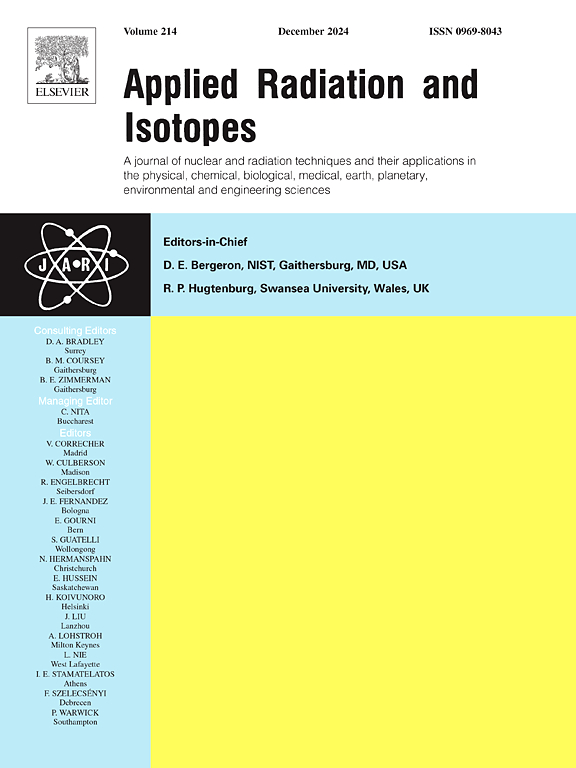Production of 67Cu at a biomedical cyclotron via 70Zn(p,α)67Cu reaction and its evaluation in a preclinical study using small animal SPECT/CT
IF 1.6
3区 工程技术
Q3 CHEMISTRY, INORGANIC & NUCLEAR
引用次数: 0
Abstract
Clinical advancements in nuclear medicine theranostics has excited a research interest in exploring novel radionuclides for medical use. The duo of the β− emitter 67Cu and the positron emitter 64Cu, has advantages over the well-established clinical pair 68Ga and 177Lu in terms of capability for high-precision therapy. Low availability has hindered the use of 67Cu whereas 64Cu has become established at a limited number of sites through production in low-to-medium energy biomedical cyclotrons. Via the reaction 70Zn(p,α)67Cu, 67Cu can also be cyclotron produced, although data on the cross sections of this reaction are sparse. Our aim in this study was three-fold: 1) to establish cross sections for relevant beam energies (14–16 MeV) of the 70Zn(p,α)67Cu reaction; 2) determine experimentally the thick target yield for 16.5 MeV proton beam; 3) establish a routine production of 67Cu for radiochemical and preclinical research. Additionally, our work aims to explore the feasibility of using biomedical cyclotrons for developing of novel therapeutic radionuclides.
Thin layers of enriched 70Zn were electrodeposited onto silver foils to employ the stacked foils technique for assessing the cross section at six energies. The thick target yield was measured experimentally using a pressed [70Zn]ZnO target. Methods were developed for solid phase extraction separation of 67Cu from the target material, as well as quality control of the product with regards to radionuclidic and radiochemical purity. Radiolabelling of PSMA-617 precursor was performed and the end product injected in a healthy mouse for a kinetic study. As a proof of concept for preclinical applications The animal was then SPECT imaged using the 185 keV gamma emission line.
Summarizing, our data confirm that biomedical cyclotrons can contribute in developing novel radionuclides, even of low cross section, for preclinical research.
在生物医学回旋加速器上通过 70Zn(p,α)67Cu 反应生产 67Cu,并在利用小动物 SPECT/CT 进行的临床前研究中对其进行评估。
核医学治疗学的临床进展激发了人们对探索新型医用放射性核素的研究兴趣。在高精度治疗能力方面,β发射体 67Cu 和正电子发射体 64Cu 的组合比临床上成熟的 68Ga 和 177Lu 组合更具优势。67Cu 的可用性较低,阻碍了它的使用,而 64Cu 则通过在中低能量生物医学回旋加速器中的生产,在有限的地点得到了应用。通过反应 70Zn(p,α)67Cu,67Cu 也可以在回旋加速器中产生,尽管有关该反应截面的数据还很稀少。我们这项研究的目的有三:1)确定 70Zn(p,α)67Cu 反应相关束能量(14-16 MeV)的截面;2)通过实验确定 16.5 MeV 质子束的厚靶产率;3)为放射化学和临床前研究建立 67Cu 的常规生产。此外,我们的工作还旨在探索利用生物医用回旋加速器开发新型治疗放射性核素的可行性。将富集的 70Zn 薄层电沉积到银箔上,采用叠箔技术评估六种能量下的横截面。使用压制的[70Zn]氧化锌靶对厚靶产量进行了实验测量。开发了从靶材料中固相萃取分离 67Cu 的方法,并对产品的放射性核素和放射化学纯度进行了质量控制。对 PSMA-617 前体进行了放射性标记,并将最终产品注射到健康小鼠体内进行动力学研究。作为临床前应用的概念验证,然后使用 185 keV 伽马发射线对动物进行 SPECT 成像。总之,我们的数据证实了生物医学回旋加速器可以为临床前研究开发新型放射性核素(即使是低截面放射性核素)做出贡献。
本文章由计算机程序翻译,如有差异,请以英文原文为准。
求助全文
约1分钟内获得全文
求助全文
来源期刊

Applied Radiation and Isotopes
工程技术-核科学技术
CiteScore
3.00
自引率
12.50%
发文量
406
审稿时长
13.5 months
期刊介绍:
Applied Radiation and Isotopes provides a high quality medium for the publication of substantial, original and scientific and technological papers on the development and peaceful application of nuclear, radiation and radionuclide techniques in chemistry, physics, biochemistry, biology, medicine, security, engineering and in the earth, planetary and environmental sciences, all including dosimetry. Nuclear techniques are defined in the broadest sense and both experimental and theoretical papers are welcome. They include the development and use of α- and β-particles, X-rays and γ-rays, neutrons and other nuclear particles and radiations from all sources, including radionuclides, synchrotron sources, cyclotrons and reactors and from the natural environment.
The journal aims to publish papers with significance to an international audience, containing substantial novelty and scientific impact. The Editors reserve the rights to reject, with or without external review, papers that do not meet these criteria.
Papers dealing with radiation processing, i.e., where radiation is used to bring about a biological, chemical or physical change in a material, should be directed to our sister journal Radiation Physics and Chemistry.
 求助内容:
求助内容: 应助结果提醒方式:
应助结果提醒方式:


